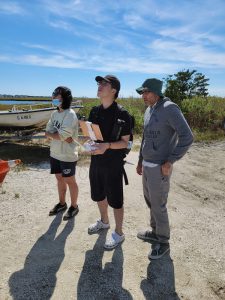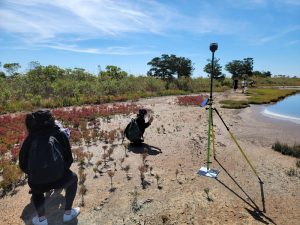by Sean Burkholder, Assistant Professor, University of Pennsylvania

UPenn students flying a UAV over the Institute
The Wetlands Institute (TWI) has been collaborating with The Environmental Modeling Lab (EMLab) at the University of Pennsylvania Weitzman School of Design over the past 5 years to collect data, visualize landscape change, and assist in the development of marsh resilience strategies through the beneficial use of sediment. The two teams have worked closely to merge cutting-edge remote sensing techniques, such as structure from motion elevation surveys and remotely-sensed multispectral data of the EMLab, with the ongoing research and education agendas of The Wetlands Institute. This collaboration has also provided students at the University of Pennsylvania with a valuable real-world case study through which to better understand the dramatic changes taking place along the coastline and the tools we have to monitor, model, and represent them.
With the site and subject matter expertise provided by TWI staff, the outputs of the collaboration can describe important landscape transformations such as wetland re-establishment on dredge placement areas. Beyond the simple visual assessments possible with standard drone imagery, the calibrated multispectral surveys can provide a species-specific understanding of the transforming wetlands that can be linked more directly to the essential habitats the wetlands provide.

Students establishing base stations and drone guidance system at TWI
Most recently, this collaborative effort used SLAMM (Sea Level Affecting Marsh Migration) models to provide projections showing the likely future conditions around The Wetlands Institute. The data provided from these models was then used to inform the resilience planning of the Institute, which included beneficially used sediment paired with other habitat-focused coastal protection. The long-term goal of this work is to imagine a more resilient facility and landscape for The Wetlands Institute that can continue to provide its research and educational functions for years to come.


